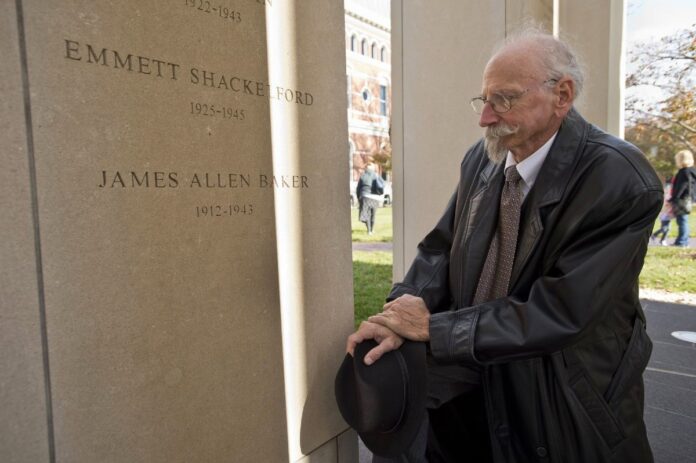
HOPE — For the second time this year, the town of Hope has lost one of its most valuable historians.
Named by Early American Life Magazine as one of the 200 Best Craftsmen in America, Charles “Chuck” Baker, 71, of Hope died of natural causes Oct. 17. His passing came eight months after the death of his former classmate and fellow historian: Hope educator and community leader Barbara Thayer Johnson.
As an artisan, Baker received accolades for extensive renovations he made at Zaharakos Ice Cream Parlor in downtown Columbus. Nationally, he gained a reputation for creating handcrafted chandeliers and metal sculptures.
In appearance, Baker was recognized by his neighbors in Hope for his handlebar-style mustache and uniquely trim beard. His appearance suggested he might have stepped out of the 19th Century, according to his younger sister, Melissa Baker Landau.
[sc:text-divider text-divider-title=”Story continues below gallery” ]
“But he was extremely talented in a unique way,” Landau said. “Few were capable of doing what he did.”
Chuck Baker was also a man who overcame many personal obstacles during his life, only to emerge a better man, his sister said.
The son of Stanley Baker (1908-1980) and Ruth Anderson Baker (1911-1995) was born at what was then Bartholomew County Hospital on March 5, 1949.
After graduating from Hauser High School in 1967, Baker went on to first get his four-year undergraduate degree before eventually earning his law degree from Wake Forest University in Winston-Salem, North Carolina.
But after becoming a defense attorney, Baker discovered he hated the job “because the job forced him to defend people he knew were guilty,” Landau said.
The job weighed so heavily on his mind that it had an adverse impact on his personal life that many feared was causing alcoholism, his sister said.
For a lengthy period of time, family members were unable to contact Baker until he returned to Hope in the late 1980s to care for his mother, Landau said. She said that as he was caring for his mother and attending the Hope Moravian Church again, Baker got sober and began working on other forms of self-improvement.
As a result, he emerged as the “gentle, compassionate and understanding soul that most people knew him to be,” his sister said.
It wasn’t always easy for Baker. Two major challenges emerged in the decade following his return to Hope: the 1995 death of his mother and the 1997 fire that destroyed his 116-year-old home, as well as nearly all of his possessions.
“You’ve got to hand it to him,” Landau said. “He was able to kick his (alcohol) dependency and stay on top of it through some tough times.”
After friends and neighbors helped him get back on his feet, Baker gained the reputation as an artisan, as well as a “jack-of-all-trades,” his sister says. He told several friends that being a craftsman was far more rewarding then practicing law.
“Chuck was an expert on anything technical regarding the past,” said Heritage of Hope CEO Michael Dean. “While he was very creative, he was someone who paid homage to the way things used to be done. And he could be very blunt about it at times.”
Yellow Trail Museum board member Jessica Brown said Baker “had a wonderful, kind spirit and always showed a willingness to get involved with local children’s activities.”
For example, he always appeared in costume for the “Goodies, Ghosts and Goblins” Halloween activities, Brown said. Baker also sponsored a fortune teller and provided an attraction called the “Cabinet of Curiosities,” which had several artifacts from Indiana, she added.
But, along with Johnson, Baker was considered one of his region’s top historians. He showed his craft skills and gave historic addresses for both the Yellow Trail Museum in Hope and the Bartholomew County Historical Society.
During the Hope Civil War Days, Baker recounted the life of Civil War veteran Henry J. Holder, who was wounded in battle in Tennessee in 1983 and returned to Hope as a farmer.
On Groundhog Day, Baker was among those who fashioned themselves after the Inner Circle in Punxsutawney, Pennsylvania to predict if a local groundhog named Grubby was predicting an early spring. In Hope, the group is called “Grubby’s Groupies.”
He also engaged in extensive historical research to ensure that his uncle’s name was added to the Bartholomew County Memorial for Veterans. Few in Hope remembered Staff Sgt. James Baker of the U.S. Army Air Corps, who died on Dec. 19, 1943 when his bomber crashed into the side of a mountain in Algeria.
Past and present students have their own memories of Baker as a mentor during the annual “Spring at the Farm,” an educational field-trip made to the Henry Breeding Farm sponsored by the Bartholomew County Historical Society.
He’s also remembered as the creator of Wizard Wands. In demand by Harry Potter fans, the basic Wizard Wand is crafted from wood saved from pruning.
[sc:pullout-title pullout-title=”Barb Johnson memorial ” ][sc:pullout-text-begin]
Town leaders in Hope are considering dedicating a recently-annexed road in memory of a highly-respected teacher and historian.
A suggestion was made to the Hope Town Council rename County Road 775E behind the Flat Rock-Hawcreek campus in honor of Barbara Thayer Johnson, who died in February.
At this time, the Hope Town Council is considering a variety of ways to honor Johnson ranging from erected a plague to renaming the road itself, Hope Town Marshal Matt Tallent said.
The Flat Rock-Hawcreek School Corp. honored Johnson twice as its Teacher of the Year, while she was named Bartholomew County’s best educator of the year in 1995. Former Indiana Gov. Evan Bayh made Johnson a Sagamore of the Wabash in 1992 for the key role she played in the moving, renovation and staffing of the historic one-room Simmons Schoolhouse.
She was also selected as The Republic’s Woman of the Year in 2016, and becoming the recipient of the 2018 Hubert Hawkins Local History Award from the Indiana Historical Society for her decades of volunteer work with the Yellow Trail Museum in Hope.
[sc:pullout-text-end]




